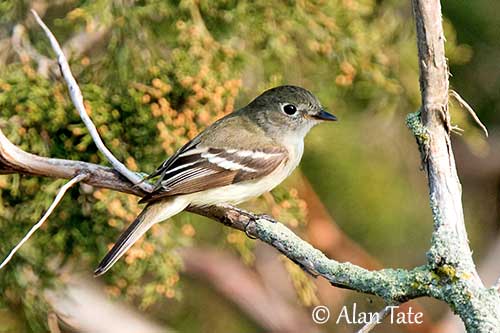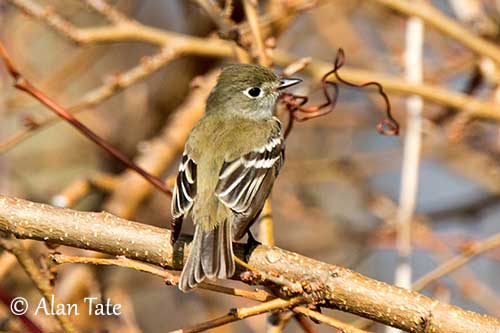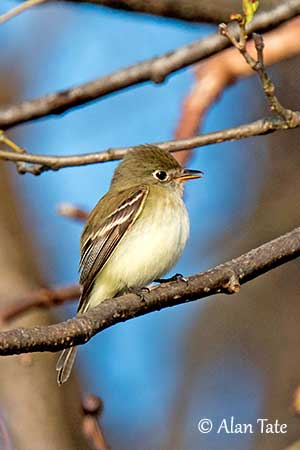
The courtship displays of the Least Flycatcher are poorly known, but they probably involve male chasing female through the trees. This species may nests in loose colonies.
The Least Flycatcher is a long-distance migrant. It migrates at night. It leaves the breeding grounds early, from July to mid-August, the adults earlier than the juveniles. It arrives in Guatemala by mid-August and El Salvador by early September.
The return migration may last 25 days. The birds leave the wintering areas in April-May and arrive in late May in N Canada. The males usually arrive six days before the females, in order to establish the territory.
The Least Flycatcher has weak, direct, fluttering flight with shallow wingbeats.
REPRODUCTION OF THIS SPECIES:
The breeding season is short, about 64 days, and takes place between late May and early August.
The nest is built by the female, and she needs 6-8 days to weave the plant material. It is a cup-shaped structure made of grass, strips of bark, lichens and plant fibres often bound together with spider or caterpillar webs. The cup is lined with softer grass, vegetal down, animal hair and feathers.
The nest is often built in young deciduous tree (maple, birch or ash), in a vertical fork with 3-4 branches. It is placed between 2 and 15 metres above the ground.
The female lays 3-5 creamy-white eggs and incubates alone during 13-15 days. The chicks are fed by both parents. They leave the nest 13-16 days after hatching, but the parents may feed them for 2-3 weeks after fledging.
PROTECTION / THREATS / STATUS:
The Least Flycatcher is described as common across the East, but the population has declined by about 53% between 1970 and 2014 (Partners in Flight).
The global population is estimated to number 33,000,000 individuals.
This species is especially affected by forest disturbances creating openings in the woodlands, and logging alters the understorey. Overgrazing by deers is also a problem.
However, the Least Flycatcher is not considered globally threatened, and the species is currently evaluated as Least Concern.
Fr: Moucherolle tchébec
Ang: Least Flycatcher
All: Zwergschnäppertyrann
Esp: Mosquero Mínimo
Ita: Tiranno minimo
Nd: Mažasis empidonaksas
Sd: dvärgempid
Photographers:
Alan & Ann Tate
AA Bird Photography
Text by Nicole Bouglouan
Sources:
HANDBOOK OF THE BIRDS OF THE WORLD Vol 9 - by Josep del Hoyo - Andrew Elliot - David Christie - Lynx Edicions - ISBN: 8487334695
FIELD GUIDE TO THE BIRDS OF NORTH AMERICA - National Geographic Society - ISBN: 0792274512
South Dakota Birds and Birding – (Terry L. Sohl)
Bird Web (Seattle Audubon Society)
Tennessee Wildlife Resources Agency
New Jersey Endangered and Threatened Species Field Guide
What Bird-The ultimate Bird Guide (Mitchell Waite)
Wikipedia, the free encyclopaedia
Least Flycatcher
Empidonax minimus
Passeriformes Order – Tyrannidae Family
INTRODUCTION:
The members of the genus Empidonax show fairly similar structure and plumage pattern, but the differentiation occurs mainly through voice and behaviour. These birds are always difficult to identify.
There are differences also in habitat, nesting habits and distribution between birds with almost similar plumage characteristics.
Numerous Empidonax species are widespread in North and Middle America. Some of them have more restricted range.
The Least Flycatcher is a North American species. It breeds from S Yukon, E to C Quebec and Maritime Provinces, and S in the USA to Wyoming, Indiana and New Jersey, and S in mountains of North Carolina. This long-distance migrant spends the winter in S Mexico and Central America.
It frequents deciduous forest, orchards and urban parks. It feeds mainly on insects caught in mid-air or from the vegetation. Some berries and seeds are also part of its diet. It nests in a cup-shaped structure usually placed in fork in small tree.
The Least Flycatcher is described as common in the East of the range, but the population has declined in the last years due to degradation of the habitat, because they are sensitive to forest disturbance.
But currently, the species is not globally threatened.

DESCRIPTION OF THE BIRD:
Biometrics:
Length: 12-14 cm
Wingspan: 19-22 cm
Weight: 8-13 g
The Least Flycatcher has greyish-olive head and upperparts. The wings are dark with two broad white/pale yellow wingbars. The pale edges of secondaries and tertials form a panel on secondaries on closed wings. The dusky tail is slightly notched.
On the whitish underparts, there is a greyish wash on breast and sides, whereas belly and undertail-coverts are tinged pale yellow.
In worn plumage, the bird is duller overall, and the wingbars are whiter and narrower.
On the head, we can see a whitish supraloral stripe and a conspicuous white eyering. The head is greyish-olive with white chin and throat.
The two-tone bill is triangular, with black upper mandible and dusky lower mandible with yellow-orange base. The eyes are dark brown. Legs and feet are blackish.
Male and female are similar.
The juvenile resembles adult in fresh plumage, but with browner upperparts and whiter underparts, and tinged buff wingbars.
RANGE:
The Least Flycatcher breeds from C Canada in S Yukon and NW interior, E to S Quebec and S Maritime Provinces, then S to USA in Wyoming, N Great Plains, New England and NW Georgia, rarely in Oregon, N California and N Colorado.
It winters in Mexico (S from Sonora and Tamaulipas) and through Central America, but rarely in S USA.

HABITAT:
The Least Flycatcher breeds in deciduous and mixed forests, second growths and mature forests. It favours forests with well-developed canopy and some shrubs and small trees in the understorey. But it also frequents urban parks, old orchards and forest borders. During winter, it is found near openings and edges of tropical forest, dense thickets, brushland and pastures. The species occurs from sea-level to 1,000/1,500 metres of elevation.
CALLS AND SONGS: SOUNDS BY XENO-CANTO
The Least Flycatcher’s common call is a short, soft “whit” sometimes given in series. Both sexes give a “chebec” (giving the bird its French name).
The dawn song may last 30-70 minutes, and the flight song is given 20-60 minutes after sunset.
The song starts with “weep” notes while the male is hopping in tree. It is then combined with “chebec” and other notes during the flight. This song described as “chebec-tooral-ooral, chebec-tooral-ooral” is used to establish the territory.
During the breeding season, it seems that all of the males in a same area often sing in unison. This behaviour decreases gradually as the breeding cycle is in progress.
The female sings rarely. She may use “chweep” notes when she defends the nest, or when her mate leaves or returns to the nest, or while feeding the chicks.
BEHAVIOUR IN THE WILD:
The Least Flycatcher feeds primarily on insects in summer. The diet includes small wasps, winged ants, beetles, caterpillars, midges and flies, and some true bugs and grasshoppers. It also takes spiders and a few berries and seeds.
It hunts from perch and flies out to catch the prey as soon as it is detected. It usually perches on dead twigs within middle to lower levels of trees, usually in fairly open spots.
Numerous insects are caught in mid-air, whereas caterpillars and spiders are gleaned from the vegetation while hovering.
